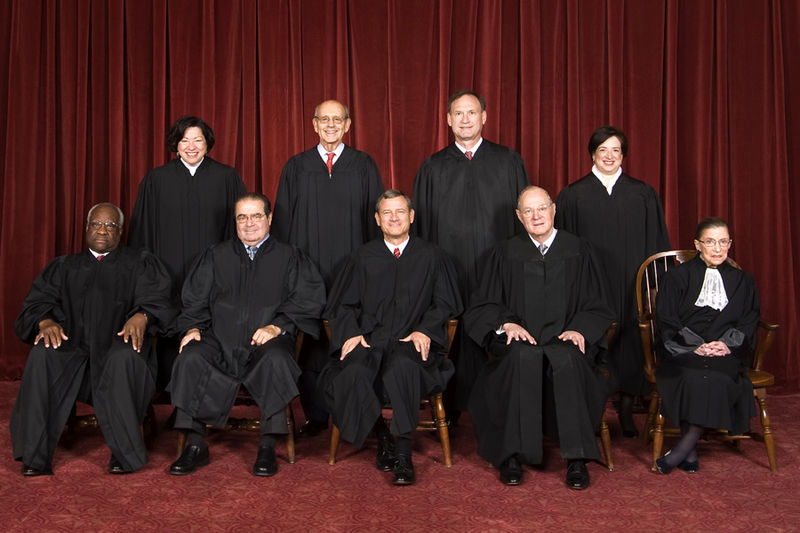 WASHINGTON — The U.S. Supreme Court was divided on Tuesday as it heard oral argument over states’ rights surrounding the definition of marriage, with some justices expressing a hesitancy to change the definition for one particular type of relationship.
WASHINGTON — The U.S. Supreme Court was divided on Tuesday as it heard oral argument over states’ rights surrounding the definition of marriage, with some justices expressing a hesitancy to change the definition for one particular type of relationship.
As previously reported, the court was set to hear argument in the case of Obergefell v. Hodges, as well as several other cases that were on appeal after the Sixth Circuit Court of Appeals ruled that states had a right to decline to recognize arrangements outside of the male-female marital union.
“[H]ere we have a whole class of people who are denied the equal right to be able to join in this very extensive government institution that provides protection for families,” attorney Mary Bonauto told the court.
“[Y]ou’re not seeking to join the institution; you’re seeking to change what the institution is,” Chief Justice John Roberts replied. “The fundamental core of the institution is the opposite sex relationship, and you want to introduce into it a same-sex relationship.”
Justice Samuel Alito then pointed to Bonauto’s argument in her legal brief that the purpose of the law—in her case Michigan’s marriage amendment—is to “demean gay people.” He asked her if she believed that all states that do so had the same intent. She replied in the affirmative.
“I think the common commonality among all of the statutes, whether they were enacted long ago or more recently, is that they encompass moral judgments and stereotypes about gay people,” Bonauto stated.
“Well, how do you account for the fact that, as far as I’m aware, until the end of the 20th century, there never was a nation or a culture that recognized marriage between two people of the same sex?” Alito replied.
Justice Anthony Kennedy made similar comments.
“This definition has been with us for millennia,” he stated. “And it’s very difficult for the court to say, ‘Oh, well, we know better.'”
Justice Stephen Breyer suggested that perhaps now was not the time to have a discussion about the matter.
“[T]he opposite view (that marriage is solely between a man and a woman) has been the law everywhere for thousands of years among people not discriminating even against gay people, and suddenly you want nine people outside the ballot box to require states that don’t want to do it to … change what marriage is to include gay people,” he said. “Why cannot those states at least wait and see whether in fact doing so in the other states is or is not harmful to marriage?”
Justice Alito asked if an affirmative ruling would open the door for all other types of arrangements to wed, such as polygamy. Bonauto argued that it would not, because she believes that the definition should be kept between two people.
“[T]hat is not the same thing that we’ve had in marriage, which is on the mutual support and consent of two people,” she contended.
Justice Antonin Scalia expressed concern over the ramifications to religious groups if the court were to consent to changing the definition of marriage.
“Right to this day, we have never held that there is a constitutional right for these two people to marry, and the minister is … an instrument of the state,” he explained. “I don’t see how you could possibly allow that minister to say, ‘I will only marry a man and a woman. I will not marry two men.'”
One man who managed to make his way into the court began calling out “Homosexuality is an abomination!” He was led outside by security. Scalia, evoking laughter, remarked that he found the man to be “rather refreshing.”
Justice Sonia Sotomayor and Justice Kagan, however, were notably more in favor of same-sex “marriage.” They grilled attorney John Bursch, who argued on behalf of the state of Michigan.
“Every single individual in this society chooses, if they can, their sexual orientation or who to marry or not marry. I suspect even with us giving gays rights to marry that there’s some gay people who will choose not to. Just as there’s some heterosexual couples who choose not to marry,” Sotomayor stated. “So, we’re not taking anybody’s liberty away.”
“In all of these [past Supreme Court] cases what we’ve talked about is a right to marry. We didn’t try to define the right more particularly. Is there a right to interracial marriage? Is there a right to marry if you’re a prisoner? We just said there’s a right to marry that is fundamental and that everybody is entitled to it unless there’s some good reason for the state to exclude them,” Kagan noted. “So, why shouldn’t we adopt the exact same understanding here?”
But Chief Justice John Roberts also joined Sotomayor and Kagan in questioning Bursch, asking how the matter wasn’t one of discrimination.
“Counsel, I’m not sure it’s necessary to get into sexual orientation to resolve the case,” he said. “I mean, if Sue loves Joe and Tom loves Joe, Sue can marry him and Tom can’t. And the difference is based upon their different sex. Why isn’t that a straightforward question of sexual discrimination?”
“All of this court’s landmark precedents in this area of sexual discrimination law have alway involved treating classes of men and women differently,” Bursch replied. “And that’s not what we have here.”
The nine justices will issue their decision in June.
Become a Christian News Network Supporter...


